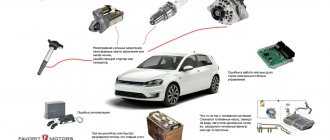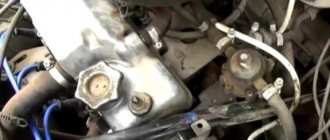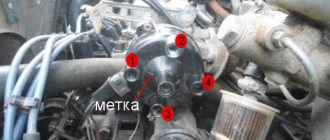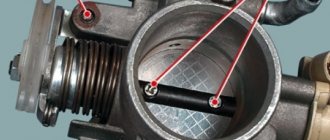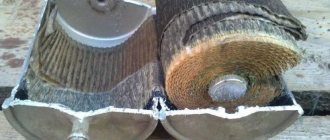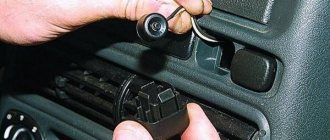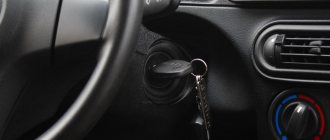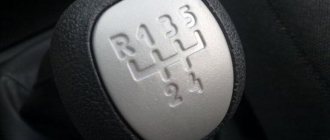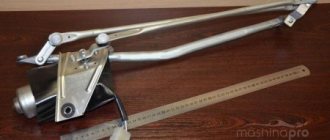Lubricating fluid is one of the main components that ensures the performance of a car, so its level and condition must be carefully monitored. Having discovered signs of oil leakage from the engine or gearbox, you must immediately identify and eliminate the cause that caused the problem. This will allow you to avoid serious troubles associated with the failure of the power unit directly during the trip and will postpone the period of forced expensive repairs for a long time.
Preparing to find a possible oil leak
Firstly and initially, before you start looking for an oil leak, you must clean the surface of the engine itself from dirt and dust. This will make it easier for you to locate the greasy stains left by motor oil or other vehicle fluids.
To clean the engine from dust and dirt, you can buy a special cleaner at a car store and wash the power unit of the car yourself. You can also pressure wash your car engine at a car wash.
This is interesting: Extended car warranty: An expensive gamble
Please note that cleaning the engine using a special cleaning spray manually or in a car wash should only be done with a cold engine. In the process of washing the engine, you must also clean not only the power unit itself, but also all hoses, brackets, the engine pan, and at the same time wash the bottom of the car and its suspension.
Attention! When cleaning the engine, you should be sure to protect all electrical connectors and exposed terminals on the machine with sealant material. Otherwise, you simply risk accelerating the corrosion of the car’s electrical components or simply not starting the engine after such a wash.
Detecting oil leaks in a car
After you have cleaned the engine, as well as other car components that may be causing the oil leak, you should immediately begin a visual inspection and search for the source of the fluid leak.
By the way, for example, if you find oil stains on the asphalt under your car, then before you start looking for an oil leak, you should first place several sheets of newspaper or plain paper under the car; this may help you quickly determine the source of such a leak. Leave the newspaper overnight (if you are going to start looking for the source of an oil leak in the morning, for example).
See also: Safety when repairing a car
By leaving a newspaper under the car overnight in the morning, you will definitely find out for yourself whether there is actually such an oil leak from the engine or from other components of the car. However, we must remember that this is not a 100% test for detecting oil leaks from a car. Remember that some oil leaks can be and are only detected when the engine is running.
In principle, this proven method can detect leaks of any liquid in a car. For example, from the gearbox, from the brake system, from the steering, and so on. units Just like in an engine, in order to promptly recognize a possible oil leak from other components of the car, you need to regularly check the level of not only engine oil, but also other auto fluids. If you begin to notice that some kind of liquid has begun to gradually decrease in one or another automotive component of the car, then you must definitely find out for yourself whether there really is such a leak.
Note: Some auto repairmen and car enthusiasts themselves use special dyes to find oil leaks, as well as any other liquid.
You can see how the process of finding a fluid leak occurs in the video below. This will give you a clear idea of how the dye can be used to locate and detect oil leaks.
You can use this method to find the source of an oil leak in your own car. But you need to pay attention to the following: this search method will cost you a little more than the one we propose to do. So:
Diagnostics at a service station - what to pay special attention to?
It also happens that after many months of struggling with leaks, the car owner goes to a service station. Here he is presented with an unrealistic bill for replacing some oil seal, he drives home happy, and the next morning he notices familiar stains on the garage floor that have not gone away. It is best to carry out an inspection at the station together with the master, so as not to miss anything important. It is also worth giving certain conditions to the specialist:
- fully describe where the liquid is leaking from, what it looks like, how much it is leaking - give all the information that you have in your arsenal regarding the problem;
- then ask to carefully examine all the details that we talked about above, while many craftsmen may persuade you, even without inspection, to simply change any part;
- order diagnostics of the unit from which the liquid is leaking, this will help to understand the reasons for this unpleasant effect, as well as eliminate the consequences of the leak in general;
- order a full service of this unit so that the technician can add oil if necessary or change it altogether, and also check the levels of all technical fluids in your car;
- In addition to the above solutions, it is also worth checking the integrity of all boots, which will help prevent the leakage of lubricant mixed with water (very similar to oil).
With such a set of interesting features, you can easily get to the point and fix the problem. Most likely, during the diagnostic process, a unit will be found that needs to be properly serviced. You can get maximum confidence with all the mentioned processes without any problems. But for this you need to choose a professional station. Do not trust the inspection and repair of your car to unverified specialists - this can have a very bad effect on the serviceability of the vehicle. The problem may also lie in banal things, such as in the following video:
Looking for an oil leak in a car
If you find drops of oil on newspaper or paper placed on the asphalt in advance, you need to conduct a direct visual inspection of these oil stains. Make sure for yourself that these are drops of the same oil that leaks from the engine or from other components of the car. Perhaps these spots are just condensation or ordinary water that has accumulated on the car overnight. How you can determine what kind of liquid drops are left on paper or newspaper, you can find out from our detailed article today right here.
If these stains on the newspaper turn out to be oil, then it’s time to begin a general inspection of all the most likely places in the car from where liquid (oil) may leak. See friends table above. If there is even a small and insignificant fluid leak, you should see wet spots on the engine or other components of the car where such a leak exists. That is why, before searching for a leak, it is necessary to flush not only the engine itself, but also the suspension, engine oil pan, gearbox, as well as a number of other vehicle components from which oil or other auto fluid may leak.
An easy way to diagnose an oil leak in a car
- — How to find an oil leak: First of all, you should carefully inspect the engine for wet areas. Then inspect the gearbox and then the steering system. If you find a wet area of any auto component, then follow it straight up to the highest point that you can easily reach or reach. This way you can find out the possible direction of the oil leak, since such a leak necessarily leaves a certain trace, i.e., it will simply stain many elements of the car.
- — Engine oil leakage due to worn engine gaskets: When looking for oil leaks, pay special attention to the engine gaskets. Most often, such a leak occurs due to wear of gaskets or seals in the engine. The same applies to transmissions (gearboxes).
- — Oil leak from the engine: Typically, such a leak leaves behind a transparent light brown trace (if the oil in the car has recently been changed), or a dark brown trace (if the engine oil has been used for a long time or a decent amount of time).
Depending on the location of the oil slick found under the car, check for possible leaks from the oil sump itself, from the front and rear crankshaft oil seals. Also check the cover that protects the timing belt or chain, as well as all areas surrounding this component.
In particular, do not forget to check the place where the cylinder head connects to the engine cylinder block. The point here is that in this very connection there is a head gasket, which often fails and begins to leak engine oil. Well, the most common cause of oil leakage from a car’s power unit is the valve cover gasket.
- — Engine oil leakage from under the filter: Among other things, if you recently changed the engine oil in the engine, then there are several other specific auto components that you need to inspect.
So, for example, you should check the tightness of the oil filter and make sure for yourself that the oil filter gasket fits tightly to the filter and to the engine itself.
Remember, friends, that when installing the oil filter, its gasket in a certain way can sometimes get a little twisted and then the filter itself can begin to leak oil.
To inspect the oil filter, you need to use any small mirror that will help you inspect the base of the filter itself. You can also take the filter with your hand and try to turn it counterclockwise to make sure it is tightened securely.
There are, of course, other common places where engine oil can leak. For example, it is necessary to inspect the oil drain plug through which engine oil may also leak.
- — Oil leakage from an automatic transmission: If your car is equipped with an automatic transmission (automatic transmission), then you need to inspect not only the body of this automatic transmission for oil leakage (as a rule, oil can leak from the transmission pan), but also the front and automatic transmission rear seals. You can recognize transmission oil (its oil stains) by color.
New or fresh transmission oil has a reddish tint. Old transmission oil in a gearbox, as a rule, is no longer transparent and has a dark brown color (shade), and may also have a burnt smell. Therefore, remember, if you decide to determine a possible oil leak not only from the engine, but also from the gearbox, then in the evening you need to lay out newspaper or paper not only under one engine, but also under the gearbox or automatic transmission itself.
- — Leakage of power steering fluid: Since in any car, in addition to engine oil and transmission oil, there are also other fluids, it is natural that due to wear of some components of the car, leakage of other fluids may occur. For example, in any car, fluid may begin to leak from the steering at any time.
Typically, this type of steering fluid leak will leave a distinct yellow color on the paper or newspaper. To see the source of such a leak from the steering, ask your assistant to start the car engine, then turn on the parking brake (handbrake) and press the brake pedal. Then ask him to slowly turn the steering wheel, first one way and then the other. If all steering components including gears, hoses and the power steering pump, as well as the power steering fluid reservoir itself, are not in order due to the fact that the steering fluid is under pressure, then when you turn the steering wheel with your assistant, you will quickly find the place where the power steering fluid is leaking .
- — Brake fluid leak: The color of the brake fluid is similar to the power steering fluid (yellow). If you find pale yellow spots under your car and, after checking the fluid level in the power steering, you find that this level is within normal limits, then you should also check the level of the brake fluid. If you, for your part, find that the brake fluid level has dropped significantly, then you urgently need to check the master brake cylinder, and with it all the brake hoses, each caliper and brake cylinders, for brake fluid leakage through them.
You can’t spoil the porridge with oil, but the engine can easily
When changing the lubricant themselves, car owners often knowingly or accidentally fill in too much fluid. Due to this violation, the pressure inside the system increases. Excess fluid seeps through gaskets and seals. Often this problem is possible on power units with a long service life. The solution is to pump out excess volume from the system.
Not every oil is suitable for a particular engine.
It is also possible to leak under the valve covers or in other places if the oil parameters do not correspond to the values recommended by the car manufacturer. It is possible that lubricant has been filled in with a viscosity lower than required.
The oil may also become too thin due to the ingress of foreign liquids. An emulsion is formed that has greater fluidity than normal motor oil. Leaks form through any engine seals.
The problem is solved by completely replacing the fluid and troubleshooting other systems. Next, you need to clean the engine with Suprotek wash or similar auto chemicals. After this, you need to fill in good quality engine oil. To prevent the consequences of a previous malfunction, it is recommended to add the tribological compound Suprotec Active Plus to the lubricant.
Repairing oil leaks in a car
Once you have found the source of the oil leak in your car, it is time to decide for yourself whether you can fix it yourself as soon as possible. For example, even if you do not have sufficient experience in servicing and repairing a car(s), you can still quite easily fix a leak that has formed, say, from the same valve cover gasket.
In certain cases, you can also fix oil leaks from the oil filter yourself. In other cases, you will need some experience in car repair and maintenance, as well as a repair manual for your specific car model. Especially if this oil begins to leak due to wear of the crankshaft seals. If you do not have and do not have such experience, then if such an oil leak is detected, you need to contact a technical auto center as soon as possible. True, for our part, we still advise drivers to establish the location of such a leak on their own in order to avoid certain deception in the future at a car service center.
Fortunately and as a rule, oil and other fluid leaks are rare in new or fresh cars. But as the mileage of the car increases and depending on the load on the car during its operation, many gaskets, seals and oil seals on the car begin to wear out, which can just lead to leakage of any of the liquids in it. Gaskets and seals in the engine can wear out especially quickly due to sudden temperature changes.
Therefore, friends, from time to time you should not only change the oil, oil and air filter, but also conduct a thorough inspection of all the main components of the car. This is the only way you can detect in time a possible leak of oil or other fluids in the car.
Don't be afraid of your car and be bold. Each of you motorists is able to inspect your car from time to time for any leakage of any liquid. You don’t need any special skills or specific skills for this. Your main task is to detect the leak in time.
Always remember that periodic inspection of the car, engine compartment and at the same time timely scheduled maintenance will help you keep your car in good and decent condition, and will also protect you from major breakdowns. All this will allow you to save not only your nerves and time in the future, but also naturally save your own money. Good luck to all friends!
Main causes and ways to eliminate them
There can be many reasons that cause oil leakage, there can be several main ones, let’s look at them:
| Malfunction | Remedy |
| During installation, they forgot to lubricate the rubber of the oil filter barrier and it became skewed or deformed during tightening | Remove the barrier, lubricate the rubber and reinstall |
| After replacement, the oil filter was not tightened | Tighten until it stops, but only with your hands without using tools. |
| Leaking due to the oil filter being overtightened during replacement | Remove the barrier; if the elastic band is deformed, replace it and install a new one without using excessive force |
| Damage to the sealing surface of the barrier (the ebb surface on the motor in contact with the rubber band) | Replace barrier |
| High lubricant pressure in the engine | There are many reasons, the oil or barrier may need to be changed |
| Unheated car. On old-style models, oil pumps are installed in which there is no oil pressure relief valve, in case of excessive increase, and the external auto-valve is either not installed or is faulty | Warm up the car, inspect the pump and valves |
| Dirty filter element | Replace the barrier. When changing the filter, tighten it only by hand. Just tighten it well. Because if you tighten it with a wrench, there is a risk of squeezing out the rubber and causing a leak again. |
If everything is in order with the lubricant and filter, but the oil is squeezed out again, then perhaps the pump itself is faulty, namely the auto-reducing valve.

